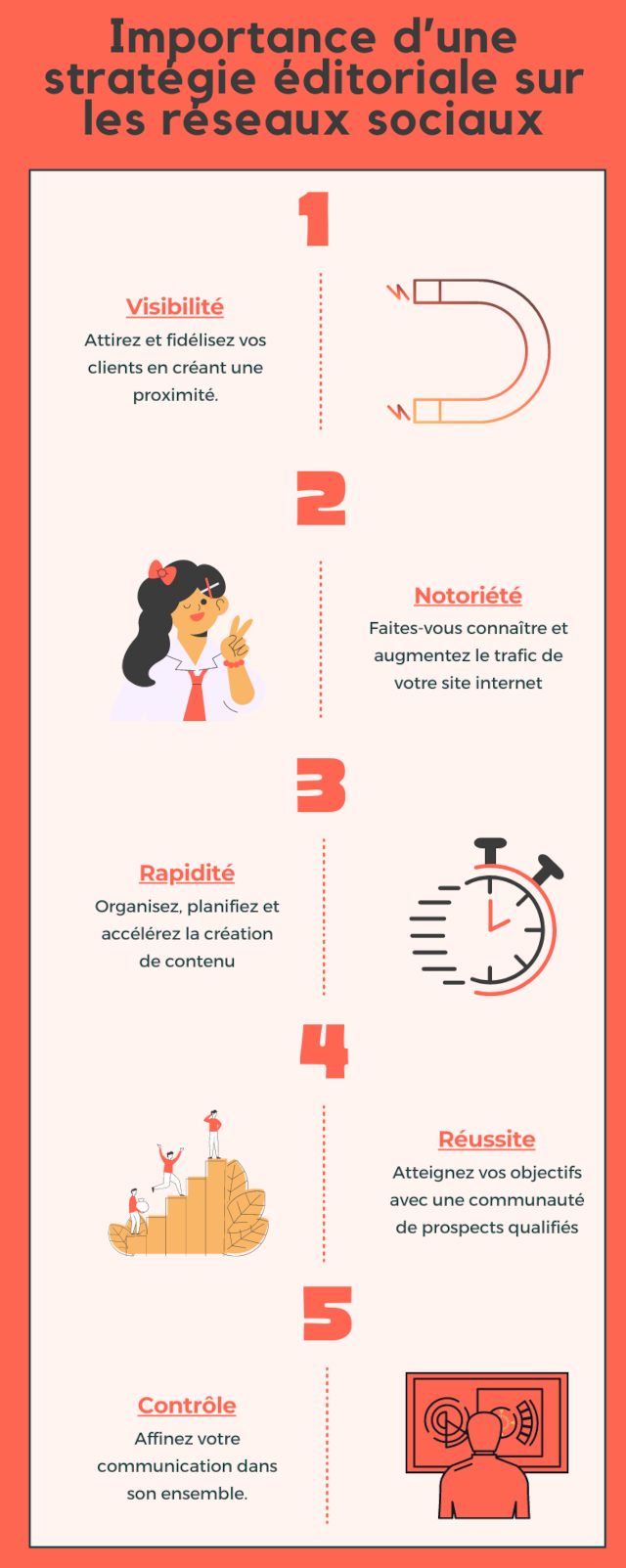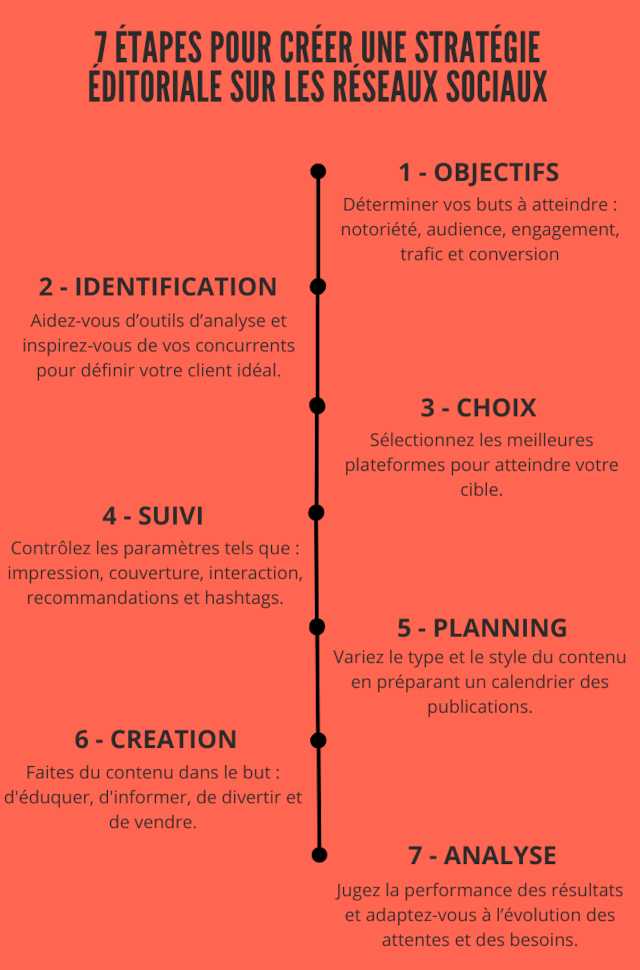Over 55% of the world's population uses social media! So, you shouldn't miss out on this communication channel to promote your business. To achieve your goals, you need to implement a social media editorial strategy. Without it, you can't know how to reach your target audience and convert them and don't have the tools to judge its effectiveness. So, let's discover the 7 steps necessary to create this essential marketing tool.
If you're in a hurry and want a quick read, you can just read the summary in the first chapter of this article.
🚀 Express Read: Understanding Social Media Editorial Strategy
Succeeding in your editorial strategy on social media is crucial for your content marketing. Here's a summary of everything you need to know!
Importance of a Social Media Editorial Strategy

- Attract and retain customers: exceptional visibility on social media.
- Develop your brand awareness: get noticed and increase traffic to your website.
- Save time: organize, plan, and speed up content creation.
- Achieve your goals: create a community of qualified prospects.
- Measure your results: refine your overall digital communication.
7 Steps to Create a Social Media Content Strategy

- Determine your goals: brand awareness, audience, engagement, traffic, and conversion.
- Research your target audience: use analysis tools and draw inspiration from your competitors.
- Choose the right platform: adapt to your target audience.
- Establish your tracking parameters: impressions, reach, interactions, recommendations, and hashtags.
- Create a publication schedule: vary the type and genre of content.
- Create engaging content: educate, inspire, entertain, and sell.
- Check your results: assess performance and adapt to evolving expectations and needs.
⚠ The Importance of Having a Social Media Content Strategy

You're probably aware that to attract new customers and retain them, your presence is essential on social media. This also allows you to develop your brand's reputation and increase your visibility. Now let's see why implementing a social media editorial strategy is also necessary to improve the effectiveness of your digital marketing.
Save Time
Of course, setting up a content strategy on social media takes time. However, it's a one-time step that will speed up the rest of your communication on social media. Indeed, by documenting your methodology, you optimize all content creation phases and save valuable time in the long run.
Achieve Your Goals
If you know your target customer and which platforms to communicate your messages on, you increase your chances of reaching qualified prospects. Perfectly targeting your audience and adapting your content accordingly is much more important than having millions of followers.
Measure Your Results
When you implement your social media editorial strategy, you clearly define your goals and determine the best ways to measure them. This technique is also an excellent way to refine your digital communication based on the success of the most performing content.
💥 7 Steps to Create a Social Media Editorial Strategy

Now let's analyze how to build a high-performing social media editorial strategy. By following this 7-step methodology before publishing your first post, you ensure you don't miss anything!
1. Determine Your Goals
To know the effectiveness of your communication on social media, you must first establish specific and measurable goals. Here are some ideas for key performance indicators (KPIs) to determine before starting to post on a social network.
- Brand awareness: demonstrate your expertise and make your business known to an interested audience.
- Size of your audience: although quality is more important than quantity, the evolution of your audience size is an important factor for your business's success.
- Engagement rate: this factor is more important than the number of followers, as it allows you to judge the interest in your posts (likes, comments, and shares).
- Website traffic: some of your social media posts should serve to redirect your audience to your sales pages or latest blog articles.
- Conversion rate: you want to achieve a goal in sales generated following the implementation of your editorial strategy.
2. Research Your Target Audience
The theory is simple: if you don't know who you're addressing, your message isn't impactful! That's why you shouldn't rely on assumptions to define your buyer persona, but on precise analysis. To achieve this, you can draw inspiration from available information on various content marketing tools:
- Google Analytics (demographic and geographic data and interests).
- Facebook Insights (https://fr-fr.facebook.com/business/insights/tools/audience-insights).
- Instagram Insights (https://fr-fr.facebook.com/business/learn/lessons/instagram-insights-tool).
To draw relevant conclusions and accurately analyze your target audience, pay particular attention to the following elements:
- activity peaks at certain times of the day;
- the best engagement rate depending on the type of content;
- the location of posts that are most visible.
However, if you just started your business, you won't have this kind of statistics available. In this case, you'll need to conduct an in-depth analysis of your competition. You can also conduct surveys by directly questioning your current customers or contacting recognized influencers in your field of activity.
3. Choose the Right Social Network
Once you know your target audience, it becomes easier to choose the most suitable social networks for your future campaigns. You can then set up an editorial line that corresponds to each platform. Here are some ideas for media to choose based on your type of business and your audience's profile.
- LinkedIn: perfectly suited for a B2B company looking to reach a professional environment.
- Instagram and Pinterest: the best way to get noticed by a predominantly female audience and through visual content.
- Facebook and Twitter: allows you to post engaging written content to a mature audience (over thirty years old).
- Snapchat and TikTok: these are the most suitable networks for reaching Generation Z, who are fond of video content.
However, be aware that posting content on social media can be extremely time-consuming. Therefore, if you don't have a community manager or even a complete editorial team, I advise you not to spread yourself too thin. Choose up to three media where you are sure to reach your audience and focus on the quality of your messages.
4. Establish Your Tracking Parameters
To be able to assess the performance of your communication on social media, focus on specific metrics. In addition to the statistics directly available on some media, tools like Buffer or Hootsuite are perfectly suited for this type of use. Here are the most relevant parameters that I recommend you monitor regularly.
- Impressions: corresponds to the number of times your content has been displayed to users. It's an ideal way to determine the virality of your content!
- Reach and accounts reached: this is the number of accounts that have seen your page or posts.
- Interactions: analyze the number of clicks, likes, messages, and shares generated by your various content to understand the engagement rate of your community!
- Recommendations: find out what others are saying about you to establish your popularity and reputation.
- Hashtags: the visibility obtained by a hashtag is a good way to know its relevance and effectiveness.
Additionally, you can also analyze the information about the source of traffic to your website. This allows you, among other things, to know the most effective social platforms and the best-performing posts. You also have the option to understand the behavior of your visitors based on where they come from.
5. Create a Publication Schedule
Before diving headfirst into content creation, you need to plan your communication. This is a crucial element for the consistency and success of your social media editorial strategy. Here's the information you should add to your editorial calendar to vary your publications enough and effectively reach your audience.
- Type of content: text, photo, infographic, video, etc.
- Genre of content: informative, storytelling, viral, promotional, contests, etc.
- Publication date: essential for organizing content creation and publication frequency.
- Targeted social network: based on the same idea, you can create different types of content that are particularly suited to a specific social media style.
By establishing this document, you first and foremost enjoy a peace of mind for the months to come. Not only is your content planned, but you ensure consistency in your communication. Plus, you're sure not to miss a critical date, such as the launch of a new product, a one-time promotion, or an important day for your business.
6. Create Engaging Content
To succeed in your social media content strategy, you want to create closeness with your audience and generate optimal engagement. To achieve this, here are the 4 styles of content you should prioritize. Note that each of these has a common goal, disguised or not: selling your services or products.
- Educational: help your customers better understand a product, service, or technical concept. You can assert your expertise while highlighting one of your products.
- Entertaining: a fun topic or contest helps animate your community by creating a pleasant atmosphere.
- Inspiring: many social media users are looking for inspiration. It's also an excellent way to encourage action.
- Commercial: this type of content mainly serves to retain your customers or reach prospects by offering them modern solutions.
Varying these types of publications is essential to avoid tiring your audience. The 50-20-20-10 model of effective distribution often used is as follows: 50% educational, 20% entertaining, 20% inspiring, and 10% commercial. However, this is just a theory, and you'll need to adapt your media strategy based on your theme.
7. Check the Results
You probably agree that if you implement a social media editorial strategy but don't know the results, it's not very interesting! So, you'll continually monitor the statistics of your posts across all used media. In digital marketing, tracking is an extremely important element, don't neglect it!
Calculating your ROI and analyzing the KPIs you previously established are the best indicators of the performance of your communication on social media. Based on this, you can then adapt your future posts. If necessary, you also have the option to review your content strategy to better align with your goals.
Do you feel ready to start your social media content strategy? Or if you've already implemented one, have you applied the same methodology? If you think a crucial element is missing in its implementation or if you have a question, don't hesitate to let us know! We'll gladly add your comments to help the SEOQuantum community be as effective as possible in its digital marketing. In conclusion, keep in mind that social media editorial strategy is an integral part of your overall digital communication strategy. To learn how to make your content marketing effective, don't hesitate to draw inspiration from this other blog post: "Example of a High-Performing Editorial Strategy".
Need to go further?
If you need to delve deeper into the topic, the editorial team recommends the following 5 contents:

